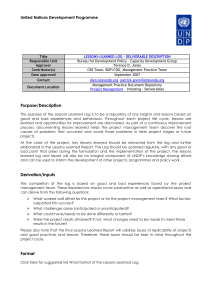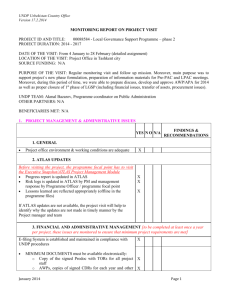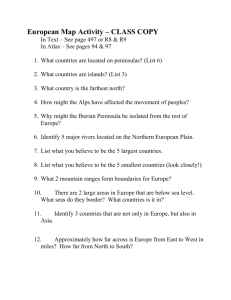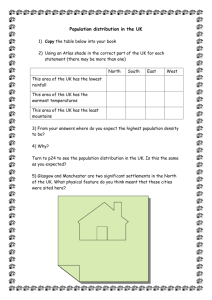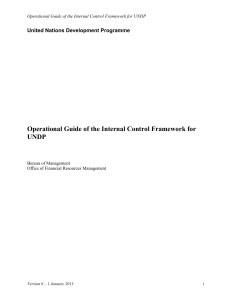Project Progress Report - Deliverable Description
advertisement
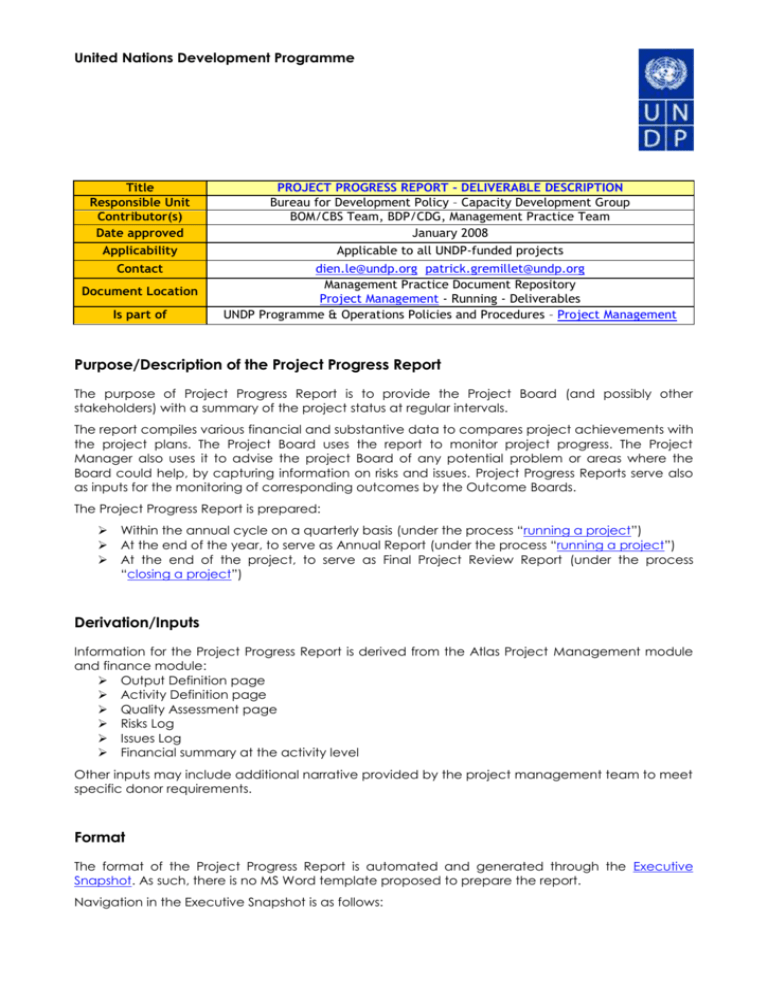
United Nations Development Programme Title Responsible Unit Contributor(s) Date approved PROJECT PROGRESS REPORT - DELIVERABLE DESCRIPTION Bureau for Development Policy – Capacity Development Group BOM/CBS Team, BDP/CDG, Management Practice Team January 2008 Applicability Applicable to all UNDP-funded projects Contact dien.le@undp.org patrick.gremillet@undp.org Management Practice Document Repository Project Management - Running - Deliverables UNDP Programme & Operations Policies and Procedures – Project Management Document Location Is part of Purpose/Description of the Project Progress Report The purpose of Project Progress Report is to provide the Project Board (and possibly other stakeholders) with a summary of the project status at regular intervals. The report compiles various financial and substantive data to compares project achievements with the project plans. The Project Board uses the report to monitor project progress. The Project Manager also uses it to advise the project Board of any potential problem or areas where the Board could help, by capturing information on risks and issues. Project Progress Reports serve also as inputs for the monitoring of corresponding outcomes by the Outcome Boards. The Project Progress Report is prepared: Within the annual cycle on a quarterly basis (under the process “running a project”) At the end of the year, to serve as Annual Report (under the process “running a project”) At the end of the project, to serve as Final Project Review Report (under the process “closing a project”) Derivation/Inputs Information for the Project Progress Report is derived from the Atlas Project Management module and finance module: Output Definition page Activity Definition page Quality Assessment page Risks Log Issues Log Financial summary at the activity level Other inputs may include additional narrative provided by the project management team to meet specific donor requirements. Format The format of the Project Progress Report is automated and generated through the Executive Snapshot. As such, there is no MS Word template proposed to prepare the report. Navigation in the Executive Snapshot is as follows: UNDP POPP – Project Management Project Progress Report – Deliverable Description Left navigation menu: Programme & Project Management > Overview of Awards > Select Award ID > Click on “View the Progress Report for this Award” The same format shall be used for Quarterly, Annual and Final Project Reports, as the Snapshot will simply extract and add information on an incremental basis and cover the entire project period, from the beginning up to the report running date. Several options are available to use and share the reports within UNDP and with partners: For internal use: o When generated through the Executive Snapshot, each Project Progress Report is automatically assigned with a unique URL which can be shared among staff having a UNDP Intranet login ID. It can then be added to the favorites/bookmarks of a browser and simply refreshed when an update is made in Atlas. For external use with partners: o A print function is available on top of the report. It can then be produced as a PDF, using the Adobe Acrobat PDF Writer, and sent by email as attachment, or simply printed on paper. o From any browser, it is also possible to copy and paste the report content to a MS Word document. The report can then be manipulated and adapted to any format/template provided by donors. o An export function to Excel is also available (next to the print button). Due to the nature of the report, transfer to MS Word is however recommended if there is a need to amend/supplement the content of the report For updating purpose: o To update the Quality Assessment component of the report, as well as risks and issues status, the Project Manager should enter information directly in the Atlas Project Management module, provided that Atlas external access to project personnel has been introduced in the office. o If the Project Manager does not have access to Atlas, but has access to the UNDP Intranet, s/he should generate the report through the Executive Snapshot, and export it to MS Word for updating. Upon completion, the updated document should be sent to the UNDP Project Assurance for data entry in the Atlas Project Management module. o If the Project Manager has access neither to Atlas nor the UNDP Intranet, the UNDP Project Assurance should generate and export the report as described above, and send the MS Word document to the Project Manager for updating. o By using any of the above options, no blank template should be required, as the updating is always made within a pre-defined framework including existing and most current information. Composition Award Basic Information: Business Unit, Award ID, Title, Implementing Partner, Award Start Date & End Date, Total Award Amount Section 1: Project Risks and Issues o Updated project risks (see Deliverable Description for the Risks Log) o Updated Project Issues (see Deliverable Description for the Issues Log) Section 2 - Output Progress. This section should reflect information contained in the Results and Resources Framework (baseline, indicators, and targets). Achievements against predefined targets are recorded at the end of the year. This section includes the following: o Long Description: Full Output statement. May also include a brief summary. o Baseline: starting point, current situation at the beginning of the project. Serves as a basis for performance measurement. o Indicators: describes how the intended results will be measured. 2 UNDP POPP – Project Management Project Progress Report – Deliverable Description Targets for year YYYY: planned achievements at the end of the period. Linked to baseline and indicators. o Results for year YYYY: actual results achieved against yearly targets Section 3 - Activity Performance. This section should reflect information contained in the Quality Management table of the Project Document template, describing how the key activity results will be monitored and assessed. For each activity result – corresponding to an Activity ID in Atlas – this section includes the following: o Start date & End date of the activity o Purpose: what is the purpose of the activity? o Description: planned actions to produce the activity result. o Quality Criteria: how/with what indicators the quality of the activity result will be measured? o Quality Method: Means of verification. What method will be used to determine if quality criteria has been met? o Criteria Date: planned date for assessing quality o User perspective: What did the project activity actually achieve, based on the above quality criteria? Were the beneficiaries satisfied? o Timeliness: Were the achievements reached within the planned timeframe o Resources Usage: Were the achievements reached within the planned budget o Rating: scale from 1 to 9. o % of completion: manual entry to reflect the percentage of completion of the activity, from a substantive point of view (this is not a % for financial delivery). o Activity Financial Summary: table including aggregate figures per activity and per year showing funds, donor, responsible party, budget, encumbrances, expenditures, and balance o Atlas Action Points The Atlas Project Management facility should be used to enter the required information as described in the Composition section. Output level information shall be entered once at the end of the process “Defining a Project” once the Project Appraisal Committee has made recommendations to approve the project document. Output level information should be refined as required at the beginning of the process “Initiating a Project. Information on annual results achieved should be recorded at towards the end of the year, or at the beginning of the next year, following the Annual Review of the Project. Activity level information, including purpose, description, quality criteria, quality method and assessment date should also be entered during the process “Initiating a Project” to the best extend possible. To properly define Quality Criteria, the inputs of the Project Manager may be required. In this case, the Activity Definition page will be fully complete during the process “Running a Project” once the project management team is in place. Quality Assessment information, risk & issues status should be updated at the end of each quarter Click here for Atlas Link giving access to the Project Management module. To learn how to update the information required to generate the Progress Report, see the Atlas Training platform: http://ondemandweb.undp.org > Results Management > Initiating a Project > Refine Output Indicators and Targets Running a Project > Update Issues Log, Monitor Risks, Update Output Status, Update Activity Status Quality Criteria Accurate reflection of information at output and activity levels. Regular updates made in all relevant components. 3 UNDP POPP – Project Management Project Progress Report – Deliverable Description Does the report provide sufficient information to properly assess the progress of the project and enable the Project Board to make appropriate decisions if required? Is the report content understandable by external partners? Is the performance measurement defined according to both quantitative and qualitative indicators? Responsibilities & Accountability During the processes “Defining a Project”, it is the responsibility of the Project Assurance to ensure that the Atlas Project Management module is activated and does reflect the information contained in the Results & Resources Framework (RRF). If the RRF is deriving from the CPAP, there may be a need to further refine and/or re-validate the baseline, indicators and targets to ensure that the information reflect the current situation. During the process “Initiating a Project”, it is the responsibility of the Project Assurance and the Project Developer to define Quality Criteria for each activity. Inputs from the Project Manager should typically be required for the proper definition of Quality Criteria. It is, however, the responsibility of the Project Assurance to activate the Quality Criteria in Atlas (i.e. to lock the information thus preventing further changes on a given criteria). During the process “Running a Project”, it is the responsibility of the Project Manager to maintain and update the Risks Log, the Issues Log and the Quality Assessment page in Atlas for each Activity ID, so that the Progress Report could be automatically generated. If the Project Manager does not have access to Atlas, please refer to the steps under the Format section above. It is the responsibility of Project Assurance to ensure that progress details are regularly updated in Atlas and properly reflected as part of the Project Progress Report (PPR). o If the project management team does not have access to Atlas, the Project Assurance (typically the UNDP Programme Officer) should be responsible for entering updates into the system, based on information submitted by the Project Manager. o If the project management team has external access to Atlas, they will update the information directly in the system. However, the UNDP Project Assurance should review the inputs by the project management team, prior to the submission of the PPR. It is the responsibility of the Project Manager to submit the Project Progress Report on a quarterly basis to the Project Board and Project Assurance. It is the responsibility of the Project Board to review the Project Progress Report and provide direction and recommendations to ensure that the agreed results are produced satisfactorily according to plans. It is the responsibility of the Project Manager to prepare the Annual Review Reports and the Final Project Review Report, and submit them to the Project Board and the Outcome Board. 4
